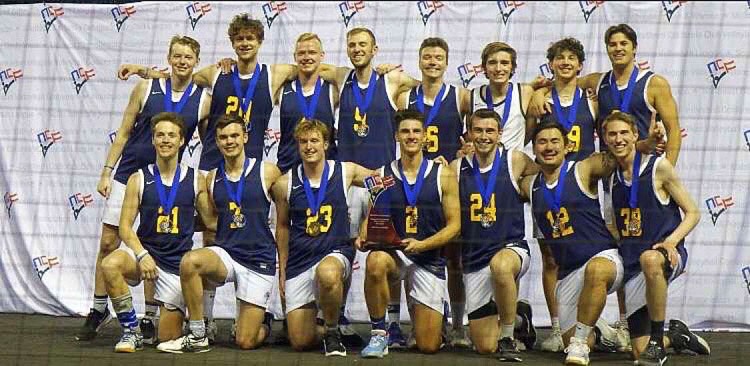 Renee Rosenow
Renee RosenowMillions of people, young and old, have been shooting each other with tiny balls filled with paint for nearly 30 years. There are many variations on how to play a game of paintball – woodsball, scenario, speedball and many more. In almost every variation of the game the same basic concept can be found as players shoot each other to eliminate the other players. That basic principal has been around since the first games were played in the early 1980s, but, thanks to a UW-Eau Claire student, things will change soon.
The Idea
Dual-degree senior Colin Karpfinger, majoring in both physics and electrical engineering, entered a robotics competition approximately a year ago. The objective of the contest was to develop a robot that could identify white targets on a black background ten feet away and shoot them.
“After that, I just started thinking of other cool things I could do with it,” Karpfinger said. “I’ve seen sentry guns in video games and movies . some people have tried to do it, but nobody had done it really well.”
Karpfinger developed his robot into “The Mercenary,” a completely autonomous paintball sentry gun.
The Gun
Many of the components of the gun system were designed by Karpfinger and his friends.
“Some of (the parts) you can buy off the shelf,” he said. “There’s a small computer inside . that you can buy, we didn’t design that … all the housings for everything are custom designed, all the electronics, with the exception of the motherboard, are custom designed.”
There are numerous problems with having a gun that just shoots at everything that moves, but Karpfinger and his associates came up with answers for them. In order to be practical for use in actual games, a good gun system would have to differentiate a player from an object blowing in the wind.
“It processes motion and color,” Karpfinger said. “If you do just motion and a tree moves in the wind, it would shoot it, but with the color it adds another equation to run things by.”
By processing color as well as motion, “The Mercenary” can also target a certain team, assuming they are all wearing the same color. The gun system also has an optional target attachment which allows players to temporarily disable the gun, or change the team at which the gun will shoot. The gun is also very accurate. Karpfinger described the gun as “accurate enough to be afraid of it.”
“A couple months back . we were pretty gutsy,” he said. “We would run in front of it and get hit a bunch of times. As time went on we slowly got more and more afraid of it. At about 35 feet you can set it up so it will hit you at least once every time.”
Now, approximately 10 months after he began seriously working on “The Mercenary,” Karpfinger is almost ready to sell his product.
“We’ve had a lot of interested people,” he said. “We’re not quite ready to ship them yet, but we’re getting really close. People want us to come down to events in California and Chicago. We have a lot of interest and people are getting excited about it.”
Karpfinger is in the process of assembling approximately 10 guns. The guns can be purchased online at http://zero-op.com/mercenary.
The Role Players and the Future
In addition to Karpfinger, there are numerous other people who have contributed to the development of “The Mercenary.” Friend Mike Caraway was responsible for the mechanical design. Friends Brant Serchen and Matt Wolf, assisted with sales ideas and the marketing as well as doubling as target practice. Juliann Sulla, another friend, did the graphic design and helped out with the Web site, logo and business cards.
Steve Dye, owner of Senasys and publisher of the Altoona Star, helped fund the project. Karpfinger was in charge of the software and the electronics. The university has been very receptive and helpful to Karpfinger, who received credits for independent study. In addition to offering credits to Karpfinger, the university is also using the demonstration video of “The Mercenary,” which can be found on the Web site, as a promotional tool.
“The (computer science) department at Eau Claire is using our video to recruit high school students and show them how cool computer science is,” Karpfinger said.
A completely autonomous sentry gun for paintball would create whole new aspects for the game of paintball. In the past, the main variation of a game of paintball was the environment in which the game was played.
It is impossible to know the future of “The Mercenary,” but it is safe to assume that, as time goes on, improvements will continue to be made. On the Web site for “The Mercenary,” Karpfinger and his fellow developers ask that customers be willing to submit “feedback to Zero-Op Systems, including video footage and gameplay details.” The feedback would be used to help aid in the further development of the gun system.
Playing a game in a forest, commonly referred to as woodsball, requires strategy and tactics that would resemble a modern army. Playing in a man-made field with strategically placed bunkers, commonly referred to as speedball, requires a completely different type of strategy unique to the game of paintball. Adding an autonomous sentry gun would add a new wrinkle to the strategies.
“I didn’t play a whole lot (of paintball) before, but I have played. One of the things that inspired me, (is that) paintball hasn’t really changed much in the last 15 years,” Karpfinger said. “The guns have gotten better, but the game hasn’t changed much.”





